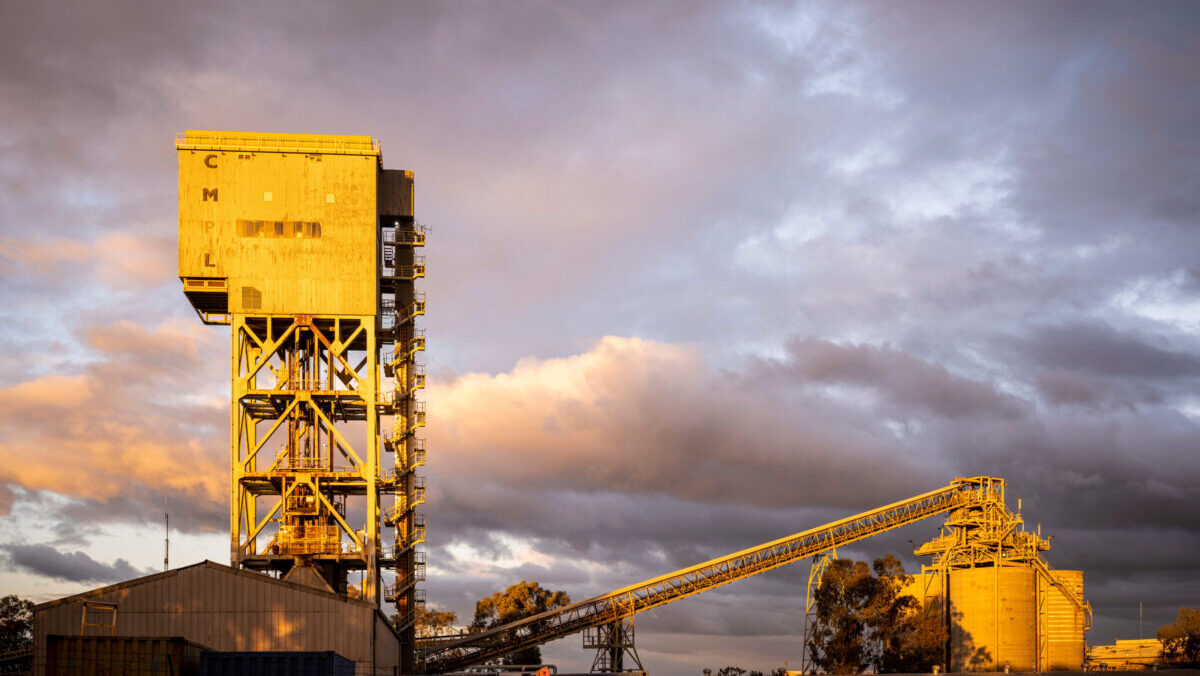Dual-listed Metals Acquisition has emerged as one of the prestige copper stocks in Australia after a $325 million ASX IPO in 2024
The miner owns the formerly Glencore controlled CSA mine in Cobar, one of the highest grade copper deposits globally
We caught up with MAC boss Mick McMullen to discuss the CSA mine, copper market and MAC’s M&A dreams
As copper rises beyond US$10,000/t, generalist Aussie investors may catch a surprise learning their options on the local bourse are a little limited.
Producers tend to skew to the smaller side while the largest producers on the ASX since the departure of OZ Minerals in a $9.6 billion takeover last year are megaminers like BHP (ASX:BHP) and Rio Tinto (ASX:RIO) who are largely more on their iron ore assets despite also being two of the world’s biggest copper companies.
Marginal and early stage juniors make up most of the rest of the sector, with a handful of standout options in between.
The most notable is $4.4b capped Sandfire Resources (ASX:SFR), which will soon boast copper production of more than 100,000tpa across Spain and Botswana, and diversified South32 (ASX:S32).
It’s into this environment two North American companies stepped this year, with the dual listing of Capstone Copper (ASX:CSC) and Metals Acquisition (ASX:MAC) on the ASX.
New York-listed Metals Acquisition was the most notable for a few reasons. Firstly, its oversubscribed $325 million IPO was among the biggest mining raisings since the peak of the last boom in 2021.
Secondly, it had offered up to US$1.1 billion to acquire Glencore’s CSA copper mine in Cobar, New South Wales, the highest grade operating copper mine outside the DRC.
Thirdly, it had at its helm Mick McMullen, a New South Wales local and Newcastle University trained geologist who won acclaim in North American in recovery jobs at TSX-listed Detour Gold and US platinum producer Stillwater, sold for billions to Kirkland Lake and Sibanye respectively.
That’s not to mention the early involvement of Australian mining big wigs Bill Beament and Nev Power, who left the one-time SPAC over a year ago.
Rather than come into a long-standing company, McMullen’s path this time is different, taking the CSA mine from within the sprawling portfolio of commodity trading and mining giant Glencore and using a little TLC to restore the 57-year-old mine to its former glory.
The first major step was taken last week with a resource and reserve upgrade that will see the 1.9km deep mine’s life extended from just six to 11 years based on drilling up to August 2023.
The new ore reserve includes 14.9Mt at 3.3% Cu and 13g/t silver for 494,000t of copper and 6.2Moz of silver. But beyond that, even before new drill hits including 19.2m at over 10% Cu, there are additional measured and indicated resources of 4.7Mt at 4.9% Cu (230,000t Cu) and inferred resources of 3.3Mt at 5.5% Cu (180,000t).
MAC wants to grow production at Cobar from 38,000-43,000t this year to 48,000-53,000t by 2026. It’s start to 2024 didn’t quite go to plan.
A power outage that saw three days of lost production and slow underground development rates due to rehab, waste storage and ground support requirements saw CSA deliver 8786t of copper in the March quarter, down 11% QoQ, with costs up 8% to US$2.15/lb.
But the value of substantial copper assets like CSA is rising sharply, with BlackRock this week saying it viewed US$12,000/t (~US$5.50/lb) as the incentive price for new mines.
We caught up with MAC head honcho Mick McMullen to discuss the CSA mine, Metals Acquisition’s M&A plans and the signal being sent by BHP’s $60 billion pursuit of Anglo American.
There’s a dearth of copper opportunities in Australia. We have the small miners, the ones that are really marginal and then the big copper companies are priced on iron ore. What was the opportunity for you with the Australian exchange?
“It’s exactly that in fact, because obviously the asset is in Australia, the market to some extent is fairly parochial down here.
“There’s a lot of funds that are looking for that copper exposure domestically. Once OZ Minerals disappeared, there isn’t really a domestic pure play copper asset of size. CSA can be that, we’ve got a bit of work to do to get through to the 50,000tpa or above production but it’s done it before.
“We are literally filling that gap in the market and as we saw when we did the IPO, we had huge demand for that equity raise, continued demand trading in the stock because people are looking for a low political risk copper exposure of some scale.
“If you’re producing small copper, it’s hard to cover your fixed costs, so you need to be of some size in order to to actually generate free cash flow for your shareholders.”
It’s a great asset. But it’s a tiny asset relative to Glencore. You’ve invested in purchasing a historic mine. It’s been a more prolific producer in the past but in the last couple of years, it’s tailed off. Is that due to a lack of investment in exploration and capital from a company in Glencore that had bigger things to focus on?
“Glencore is a huge company. Their management team has to do what’s right for their shareholders, which is to focus on those big assets that move the needle for their business. Now, for them, that’s not CSA. I think they have invested a fair bit of capital in the mine, not a lot of exploration.
“You’d have seen from our resource and reserve update last week that we’ve just doubled the reserve life, which gives us a platform now to plan for long term. Historically, it’s always been a short reserve life and so then you have been doing short term plans on an annual basis.
“Now, we can put in a proper long term plan. I think for Glencore, just more fundamentally, even if they did everything we’re doing, it still wouldn’t move the needle for ’em. It’s not the right size asset for that size company.”
If you look at the resource grade that you put out last week at almost 5%, where can you actually go to find 5% copper? I imagine that hasn’t turned up a lot in your due diligence.
“It is the highest grade copper mine outside of the Congo, and we’re very clear that we’re sticking to Tier 1 jurisdictions and maybe I’m biased because I’m from north-western New South Wales many years ago, but I think Cobar is the best jurisdiction that you can possibly be in and I’ve worked all over the world.
“To get 5% copper with a lot of excess infrastructure in that jurisdiction, it truly is a unique proposition.”
You were founded as a blank check company as well. So the idea was to find an acquisition that fit. Has that proven to you so far that was the right mine to take on as your foundation asset?
“I think so. Our background very much is asset turnarounds.
“I spent over a decade in North America, doing turnarounds of actually much bigger assets than this one, both open pit and underground.
“So it plays to our core skill set of operational improvement and turnarounds.
“Fantastic grade, clearly we knew there was a lot of potential in the resource, but now we’ve delivered on that and it’s all still open. And there’s a lot of excess capacity in the infrastructure.
“In our group we’ve built mines before but I didn’t want to be building a mine in this capital cycle where we are, with capex overruns and time delays. Turnarounds, we can deliver much faster for investors and so therefore it’s right up our alley, actually.”
We saw IGO look like they were going to bid for the asset and then as soon as it got out to the media, the investors who tend to not like M&A, basically seem to have warned them off it.
“Well, again, we were formed specifically to go and acquire stuff. That was the whole sole purpose of the company.
“And so every shareholder that was in it (knew) that was the that was the plan. I think the other thing is, because I’ve had so long in North America, our register at the time was very North American centric, with a bit out of London, and a little bit out of Australia.
“But all of those people knew our track record from operational turnarounds. And I think it’s probably fair to say that buying a turnaround-style asset, everyone says that’s exactly Mick’s modus operandi. I’m not sure shareholders at IGO sort of viewed them as turnaround specialists.”
Mick McMullen is viewed as a turnaround specialist. Pic: Supplied
Speaking of acquisitions. It came up on the quarterly call a bit. You got asked what you might be interested in and it sounded like everywhere except for Sub-Saharan Africa.
“Even in Latin America, places like Ecuador, Brazil or Peru, they’re not really for us, right. Chile sort of falls into the bucket.
“It’s got to be a Tier-1 jurisdiction and we’ve got to have operated there before within our team, we don’t want to go into some new place and try and learn the ropes. We’re definitely not going to Africa, I can assure you of that, but even in Latin America there’s a fair few places we won’t go as well.
“Even within the US there’s really only four states in the US that we would go to.”
What are you looking for in the next acquisition? Will it be picking up a few smaller assets that you can combine that are in the 10-20,000tpa range? Or do you want something that’s a replica of a CSA (or as close to given there’s not many mines with the grade)?
“It’s almost impossible to find something that is as good as CSA.
“So, therein lies the problem because when you do you your next deal you’re trying to upgrade your portfolio quality. Our preference is to go bigger than smaller. Aggregating a series of small mines, quite frankly, there’s as much trouble in a 50,000t copper a year mine as there is in 15,000t.
“So you might as well spend that time and get the bigger one. It comes down to value. So we’ve got to be able to see a pathway to value whether that’s turnaround or synergies or some way that we look at the asset different to the incumbent owner.
“Ideally in copper, but copper plus something is usually the way it sort of goes. Ultimately it’s value, it comes down to whether we can create value for shareholders out of that transaction.”
You got asked recently about the Mt Isa Mines project. Given that Glencore is looking to shut that down, whoever buys it would need to take a substantially different perspective on the asset than Glencore did. Is it something attractive to you to have to go through the weeds and look for ways to keep something like that alive?
“It’s a matter of public record in our in our US proxy filings that initially, if you go back 2 & 1/2 years ago, we went to Glencore with a proposal to buy not only CSA but Mt Isa from them.
“We ended up going down the path of buying CSA only from them. We are turnaround specialists, we like Australia as a jurisdiction, we’d like to get much larger and so it would be on our list of things that we’d looked at.
“It’s not the only thing we’d look at, but again as a director of this company, you have a duty to look at all options to create value. Acquisition’s in our name for a reason. We’re pretty active, but honestly, it just comes down to value for shareholders.”
Is there support from say the Queensland Government for a process there?
“It’s hard to say. I think that’s probably early days there in terms of what is likely to happen.
“And yes, Glencore has announced the closure of the copper side of the business. But again we have to form a view on how would we run a business and what would our cost structure be just like we did at CSA. That may be the same as the incumbent owner, or it may be materially different as an incumbent owner.
“No one’s giving away copper mines these days. And so in order to buy a copper mine or copper-rich mine, you fundamentally need to have a different view on something than the incumbent owner.
“That may be you can run it differently or there’s a different mine plan you can put in place.
“We tend to run with consensus pricing, so we tend to not form a view directionally.
“We’re very bullish copper. But at the end of the day, we run on consensus, because that’s how the market will judge us. So we don’t try and back ourselves as we’re the best commodity picker, we just think copper has great fundamentals, very tight in the physical market, very tight in the smelter market.
“Clearly the copper price has moved higher, but we just run everything on consensus.”
Blackrock came out this week said you need US$12,000/t to incentivise new mines. In that sort of scenario what does it mean for a company running an operation like CSA and do you think US$12,000/t is realistic?
“Look, I do. We’re at US$10,000 a tonnish roughly now.
“It’s not just the incentive price, it’s the time to permit and build a new mine. And if you look at the capex blowouts on those big mine.
“CSA is not really going to move the global needle for production. You need big mines, typically in Latin America or Africa and the time to build those mines is very long now.
“I hate to use the terms but you’re going to have stronger for longer copper prices, because you can’t flick a switch and miraculously produce all this copper.
“I saw those comments from BlackRock. I’m not in the business of forecasting commodity prices. But will it be US$10,000+, US$12,000? I think it will have to be for some time.“
“What does that mean for CSA? It means that mine makes a lot of free cash flow at those prices.”
Lastly, the BHP-Anglo American deal. It seems like copper — and maybe to a smaller extent met coal — is the aim there. How does that sort of acquisition if it happens, flow on to the rest of the industry and are there going to be opportunities for companies in your tier to see if there’s stuff that can be picked up from the non-core set?
“I think it’s a great opportunity. Clearly, in BHP’s mind they’re pricing in (more than) US$3.50/lb copper for that transaction to work and they would have a pretty good idea of supply and demand and where prices will go.
“That is clearly the jewel in the crown that they’re looking for and they’re pretty good copper assets inside Anglo. So I think you’re starting to see larger companies pricing a higher price than where it’s been.
“Obviously always whenever there’s an opportunity to pick up assets, that are smaller assets out of larger companies that’s our niche.
“It remains to be seen, a lot of things are going to happen in that transaction, before it gets to a closure … if it gets to a closure. But we’re always on the lookout for assets falling out of those large companies.”
Metals Acquisition (ASX:MAC) share price today
The post Q+A: Why Metals Acquisition’s Mick McMullen wants to breathe new life into Australia’s highest grade copper mine appeared first on Stockhead.






















